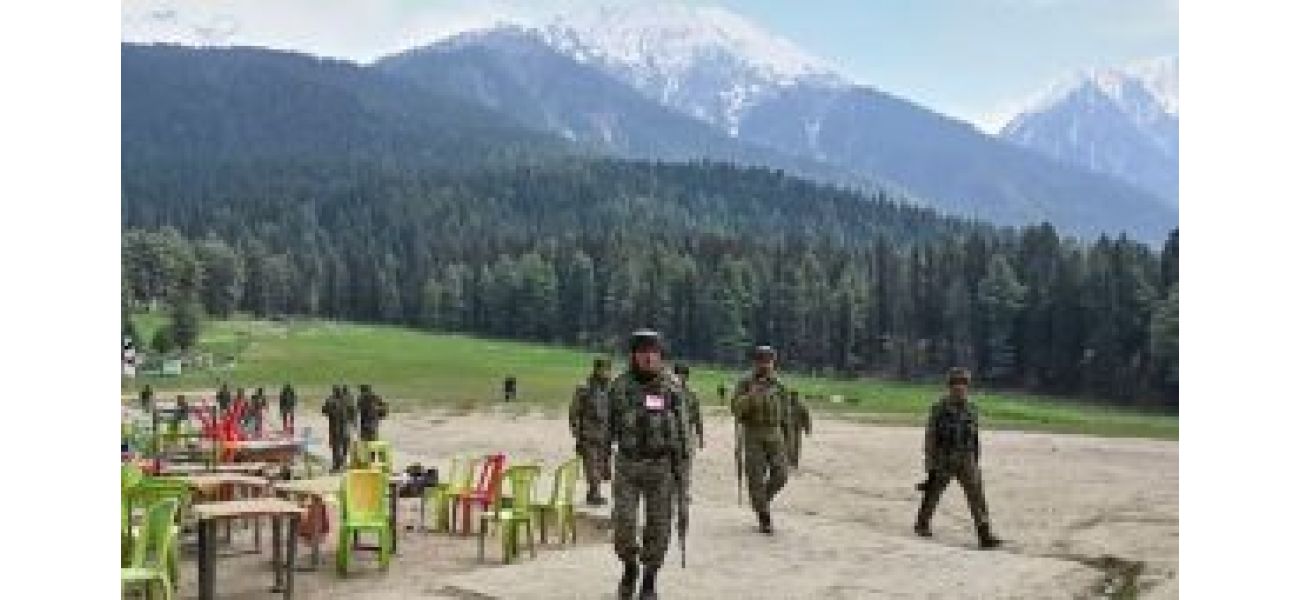Officials state that prior to the Pahalgam attack, intelligence agencies had warned of potential attacks on tourists near the outskirts of Srinagar.
Intelligence agencies warned of potential targeting of tourists in outskirts of Srinagar, leading to increased security presence.
May 3rd 2025.

In the days leading up to the tragic terror attack in Pahalgam, officials in the know shared that intelligence agencies had raised concerns about potential targeting of tourists. Specifically, those staying in hotels on the outskirts of Srinagar, nestled in the foothills of the Zabarwan range. This information prompted a heightened security presence in these areas, with top police officials camping in Srinagar to oversee combing operations in Dachigam, Nishat, and other adjacent areas.
These areas gained attention and saw increased patrolling due to a previous terrorist attack on a construction site in Gangangir, Sonamarg last October. The attack resulted in the death of seven people, including a doctor, and occurred on the other side of the Zabarwan range, overlooking the city of Srinagar. Despite a two-week operation and extensive searches based on the intelligence, no breakthroughs were made and the operation was called off just two days before the attack in Pahalgam, where 26 tourists were killed.
There were also reports suggesting that terrorists had planned to carry out this heinous act during the visit of Prime Minister Narendra Modi, who was scheduled to flag off the first train from Katra to Srinagar last month. Officials believe that this could be an attempt by Pakistan to overshadow the inauguration of the railway link, which aims to connect Kashmir with the rest of the country. However, the visit was postponed due to adverse weather conditions in the Katra area, and new inauguration dates are expected to be announced soon.
According to the officials, the state and non-state actors across the border are not happy with the railway link and do not want it to receive international attention. This could be the reason behind their plan to carry out such barbaric killings. The attack in Pahalgam, where two local terrorists had already mingled with the tourists, was quickly followed by the herding of tourists into a food court complex, where two other terrorists, reportedly from Pakistan, fired and killed 26 of them. The aim of this attack was to create fear among citizens and possibly provoke retribution attacks against Kashmiris in other parts of the country.
The Chief Minister of Jammu and Kashmir, Omar Abdullah, took swift action and contacted top officials in New Delhi, prompting them to direct state governments to ensure the safety of Kashmiri locals in their respective states. However, officials have also noted a concerning trend in the type of terrorism in Jammu and Kashmir, with the recovery of advanced weaponry like M-series rifles, sniper rifles, and armour-piercing bullets at encounter locations. These weapons are suspected to be leftover from NATO troops in Afghanistan.
The authorities also cautioned against using tourist arrivals as the sole indicator of peace in Jammu and Kashmir. They pointed out the case of former Chief Minister Ghulam Nabi Azad, who had used tourist arrivals as a measure of normalcy in the past. Shortly after this statement, four tourists were killed and six others injured in a terrorist attack on a bus carrying tourists from Gujarat in Srinagar. The officials stressed that in a conflict zone, tourism should primarily be viewed as an economic activity rather than a barometer for gauging normalcy.
Addressing reports about Baisaran not being granted clearance for opening to tourists, officials clarified that the area remains accessible throughout the year except during the Amarnath Yatra or periods of heavy snowfall. In fact, the Jammu and Kashmir administration had issued a tender for Baisaran, which was awarded to an individual from South Kashmir last August. The meadow has since been fenced, and a zipline facility has been established.
Finally, the officials also mentioned the practice of blasting houses, which was previously used in counter-terrorism operations but has since been halted at the request of the elected government of Jammu and Kashmir. They advised New Delhi to take note of the spontaneous protests in the entire Kashmir valley following the Pahalgam attack, which were reminiscent of the public movements seen during the Nirbhaya case in New Delhi.
These areas gained attention and saw increased patrolling due to a previous terrorist attack on a construction site in Gangangir, Sonamarg last October. The attack resulted in the death of seven people, including a doctor, and occurred on the other side of the Zabarwan range, overlooking the city of Srinagar. Despite a two-week operation and extensive searches based on the intelligence, no breakthroughs were made and the operation was called off just two days before the attack in Pahalgam, where 26 tourists were killed.
There were also reports suggesting that terrorists had planned to carry out this heinous act during the visit of Prime Minister Narendra Modi, who was scheduled to flag off the first train from Katra to Srinagar last month. Officials believe that this could be an attempt by Pakistan to overshadow the inauguration of the railway link, which aims to connect Kashmir with the rest of the country. However, the visit was postponed due to adverse weather conditions in the Katra area, and new inauguration dates are expected to be announced soon.
According to the officials, the state and non-state actors across the border are not happy with the railway link and do not want it to receive international attention. This could be the reason behind their plan to carry out such barbaric killings. The attack in Pahalgam, where two local terrorists had already mingled with the tourists, was quickly followed by the herding of tourists into a food court complex, where two other terrorists, reportedly from Pakistan, fired and killed 26 of them. The aim of this attack was to create fear among citizens and possibly provoke retribution attacks against Kashmiris in other parts of the country.
The Chief Minister of Jammu and Kashmir, Omar Abdullah, took swift action and contacted top officials in New Delhi, prompting them to direct state governments to ensure the safety of Kashmiri locals in their respective states. However, officials have also noted a concerning trend in the type of terrorism in Jammu and Kashmir, with the recovery of advanced weaponry like M-series rifles, sniper rifles, and armour-piercing bullets at encounter locations. These weapons are suspected to be leftover from NATO troops in Afghanistan.
The authorities also cautioned against using tourist arrivals as the sole indicator of peace in Jammu and Kashmir. They pointed out the case of former Chief Minister Ghulam Nabi Azad, who had used tourist arrivals as a measure of normalcy in the past. Shortly after this statement, four tourists were killed and six others injured in a terrorist attack on a bus carrying tourists from Gujarat in Srinagar. The officials stressed that in a conflict zone, tourism should primarily be viewed as an economic activity rather than a barometer for gauging normalcy.
Addressing reports about Baisaran not being granted clearance for opening to tourists, officials clarified that the area remains accessible throughout the year except during the Amarnath Yatra or periods of heavy snowfall. In fact, the Jammu and Kashmir administration had issued a tender for Baisaran, which was awarded to an individual from South Kashmir last August. The meadow has since been fenced, and a zipline facility has been established.
Finally, the officials also mentioned the practice of blasting houses, which was previously used in counter-terrorism operations but has since been halted at the request of the elected government of Jammu and Kashmir. They advised New Delhi to take note of the spontaneous protests in the entire Kashmir valley following the Pahalgam attack, which were reminiscent of the public movements seen during the Nirbhaya case in New Delhi.
[This article has been trending online recently and has been generated with AI. Your feed is customized.]
[Generative AI is experimental.]
0
0
Submit Comment





